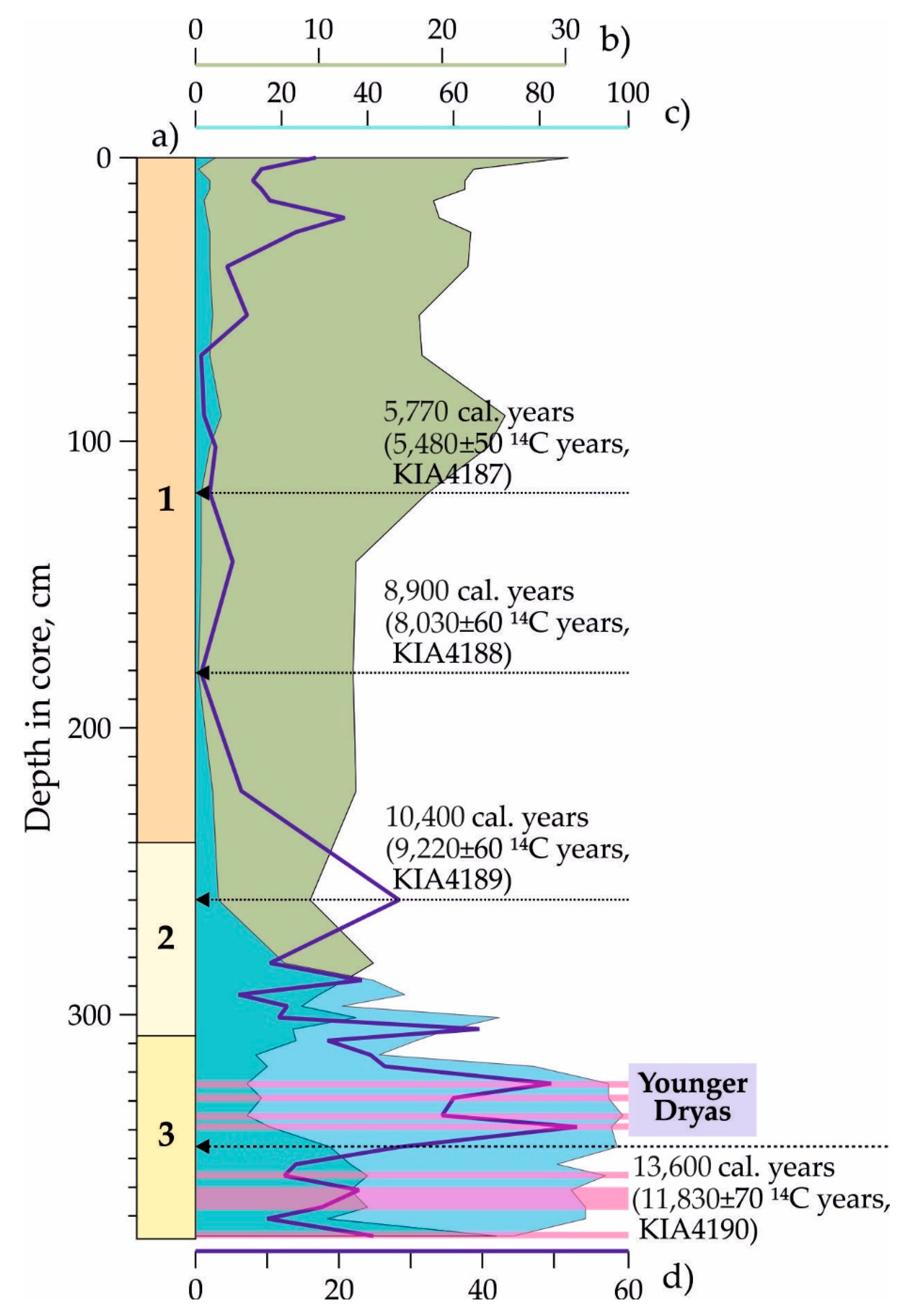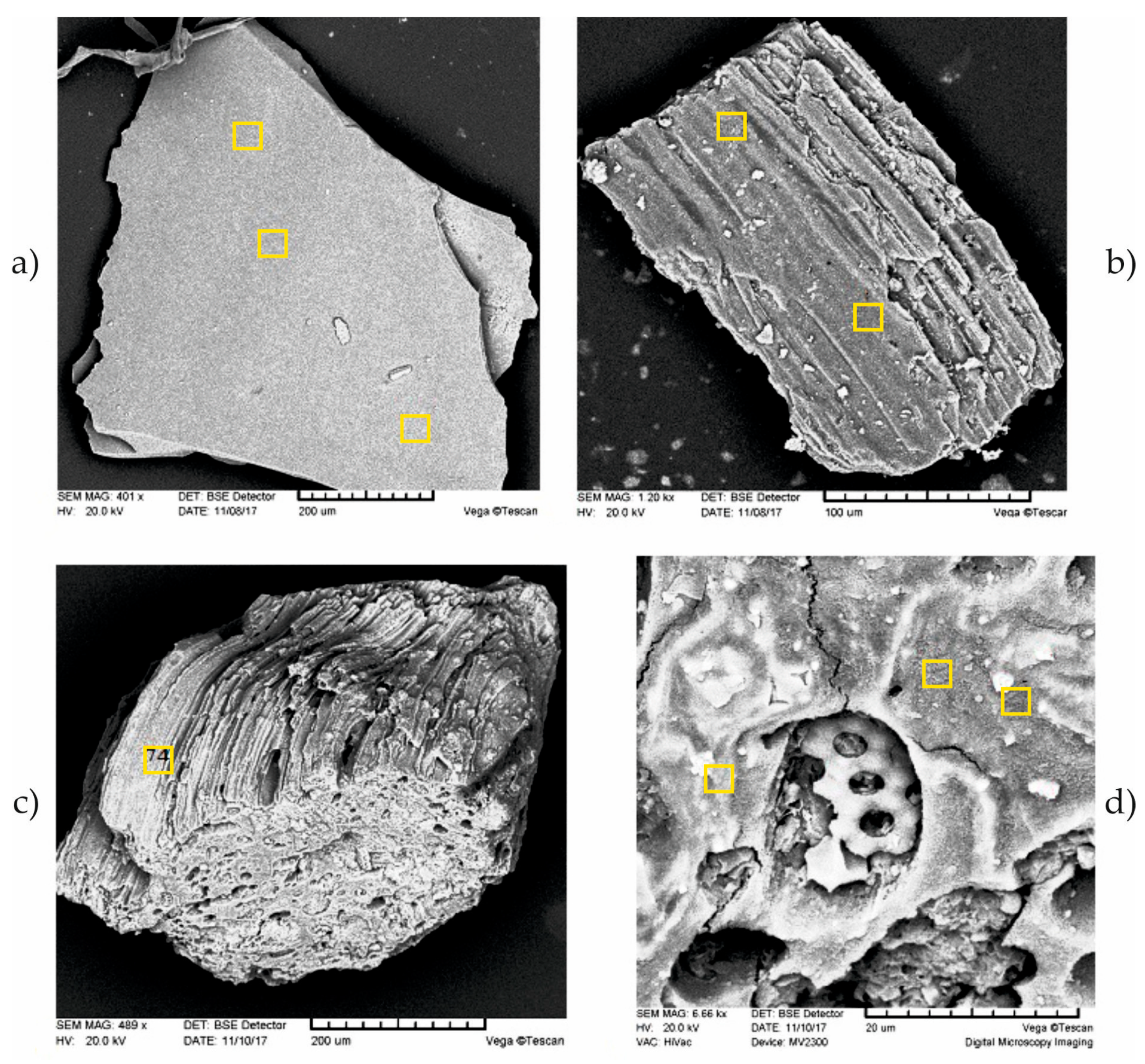The Distal and Local Volcanic Ash in the Late Pleistocene Sediments of the Termination I Interval at the Reykjanes Ridge, North Atlantic, Based on the Study of the Core AMK-340
Abstract
:1. Introduction
2. Materials and Methods
3. Results
3.1. Morphological Types of the Eruptive Material in the Studied Sediment Samples
3.2. Distribution of the Eruptive Material in the Studied Sediment Samples
3.2.1. The Core Unit of 323–340 cm with an Age of 12,170–12,840 Years
3.2.2. The Core Unit of 355–378 cm with an Age of 13,600–14,540 Years
3.3. Chemical Composition of the Volcanic Material in the Studied Samples
3.3.1. The Core Unit of 323–340 cm with an Age of 12,170–12,840 Years
Sample 323–325 cm
Sample 328–330 cm
Sample 334–336 cm
Sample 338–340 cm
3.3.2. The Core Unit of 355–378 cm with an Age of 13,600–14,540 Years (Figure 8)
4. Discussion
5. Conclusions
Supplementary Materials
Author Contributions
Funding
Acknowledgments
Conflicts of Interest
References
- Lowe, D.J. Tephrochronology and its application: A review. Quat. Geochronol. 2011, 6, 423. [Google Scholar] [CrossRef]
- Turney, S.M.; Lowe, J.J.; Davies, S.M.; Hall, V.A.; Lowe, D.J.; Wastegård, S.; Hoek, V.Z.; Alloway, B.V. Tephrochronology of Last Termination sequences in Europe: A protocol for improved analytical precision and robust correlation procedures (a joint SCOTAV-INTIMATE proposal). J. Quat. Sci. 2004, 21, 335–345. [Google Scholar] [CrossRef]
- Abbott, P.M.; Davies, S.M. Volcanism and the Greenland ice-cores: The tephra record. Earth-Sci. Rev. 2012, 115, 173–191. [Google Scholar] [CrossRef]
- Bourne, A.J.; Cook, E.; Abbot, P.M.; Seierstad, I.K.; Steffensen, J.P.; Fischer, H.; Schnupback, S.; Davies, S.M. A tephra lattice for Greenland and a reconstruction of volcanic events spanning 25–45 ka b2k. Quat. Sci. Rev. 2015, 118, 122–141. [Google Scholar] [CrossRef]
- Thordarson, T.; Höskuldsson, A. Postglacial volcanism in Iceland. Jökull 2008, 58, 198–228. [Google Scholar]
- Gudmundsdóttir, E.R.; Larsen, G.; Björck, S.; Ingólfsson, Ó.; Striberger, J. A new high-resolution Holocene tephra stratigraphy in eastern Iceland: Improving the Icelandic and North Atlantic tephrochronology. Quat. Sci. Rev. 2016, 150, 234–249. [Google Scholar] [CrossRef]
- Thornalley, D.J.R.; McCave, I.N.; Elderfield, H. Tephra in deglacial ocean sediments south of Iceland: Stratigraphy, geochemistry and oceanic reservoir ages. J. Quat. Sci. 2011, 26, 190–198. [Google Scholar] [CrossRef]
- Kvamme, T.; Mangerud, J.; Furnes, H.; Ruddiman, W.F. Geochemistry of Pleistocene ash zones in cores from the North Atlantic. Nor. Geol. Tidsskr. 1989, 69, 251–272. [Google Scholar]
- Lane, C.; Blockley, S.; Mangerud, J.; Smith, V.; Lohne, S.; Tomlinson, E.; Matthews, I.; Lotter, A. Was the 12.1 ka Icelandic Vedde Ash one of a kind? Quat. Sci. Rev. 2012, 33, 87–99. [Google Scholar] [CrossRef]
- Tomlinson, E.L.; Thordarson, T.; Lane, C.S.; Smith, V.C.; Manning, C.J.; Müller, W.; Menzies, M.A. Petrogenesis of the Sólheimar ignimbrite (Katla, Iceland): Implications for tephrostratigraphy. Geochim. Cosmochim. Acta 2012, 86, 318–337. [Google Scholar] [CrossRef]
- Griggs, A.J.; Davies, S.M.; Abbott, P.M.; Rasmussen, T.L.; Palmer, A.P. Optimising the use of marine tephrochronology in the North Atlantic: A detailed investigation of the Faroe Marine Ash Zones II, III and IV. Quat. Sci. Rev. 2014, 106, 122–139. [Google Scholar] [CrossRef]
- Lisitzin, A.P.; Zonenshain, L.P. Rift Zone of the Reykjanes Ridge: Tectonics, Magmatism, Conditions of Sedimentation; Nauka Press: Moscow, Russia, 1990; p. 239. (In Russian) [Google Scholar]
- Matul, A.; Barash, M.S.; Khusid, T.A.; Behera, B.; Tiwari, M. Paleoenvironment Variability during Termination I at the Reykjanes Ridge, North Atlantic. Geosciences 2018, 8, 375. [Google Scholar] [CrossRef]
- Matul, A. Late Quaternary paleoceanology of the North Atlantic based on radiolaria analysis data. Oceanology 1994, 34, 550–555. [Google Scholar]
- Matul, A. On the problem of paleoceanological evolution of the Reykjanes ridge region (North Atlantic) during the last deglaciation based on a study of radiolaria. Oceanology 1994, 34, 806–814. [Google Scholar]
- Stuiver, M.; Reimer, P.J.; Reimer, R.W. CALIB 7.1 [WWW program], 2018. Available online: http://calib.org (accessed on 1 July 2019).
- Mortensen, A.K.; Bigler, M.; Grönvold, K.; Steffensen, J.P.; Johnsen, S.J. Volcanic ash layers from the Last Glacial Termination in the NGRIP ice core. J. Quat. Sci. 2005, 20, 209–219. [Google Scholar] [CrossRef]
- Rasmussen, S.O.; Bigler, M.; Blockley, S.P.; Blunier, T.; Buchardt, S.L.; Clausen, H.B.; Cvijanovic, I.; Dahl-Jensen, D.; Johnsen, S.J.; Fischer, H.; et al. A stratigraphic framework for abrupt climatic changes during the Last Glacial period based on three synchronized Greenland ice-core records: refining and extending the INTIMATE event stratigraphy. Quat. Sci. Rev. 2014, 106, 14–28. [Google Scholar] [CrossRef] [Green Version]
- Lyakhovich, V.V. On pisolitic tufa on the Siberian platform. Dokl. AN SSSR 1956, 110, 137–139. (In Russian) [Google Scholar]
- Moore, J.Y.; Peck, D.L. Accretionary lapilli in volcanic rocks of the Western Continental United States. J. Geol. 1962, 70, 182–194. [Google Scholar] [CrossRef]
- Kotova, L.N. Ash lapilli from Devonian volcanogenic-sedimentary series of Tarbagai Ridge. Lithol. Miner. Resour. 1966, 2, 58–64. (In Russian) [Google Scholar]
- Shcherbakova, M.N. Ash rain in volcanogenic sediments of near-Balkhash (Kazakhstan). Lithol. Miner. Resour. 1972, 1, 155–160. (In Russian) [Google Scholar]
- Dzozenidze, G.S.; Markhinin, E.K. Volcanoclastic products and problem of their evolution. In Problems of the Volcanogenic-sedimentary Lithogenesis; Nauka Press: Moscow, Russia, 1974; pp. 4–12. (In Russian) [Google Scholar]
- Le Maitre, R.W.; Bateman, P.; Dudek, A.; Keller, J.; Lameyre, J.; Le Bas, M.J.; Sabine, P.A.; Schmid, R.; Sorensen, H.; Streickeisen, A.; et al. A Classification of Igneous Rocks and Glossary of Terms; Blackwell Scientific Publications: Oxford, UK, 1989; p. 193. [Google Scholar]
- Mutschler, F.E.; Rougon, D.J.; Lavin, O.P.; Hughes, R.D. PETROS—A Data Bank of Major Element Chemical Analyses of Igneous Rocks for Research and Teaching (version 6.1); NOAA, National Geophysical and Solar-Terrestrial Data Center: Boulder, CO, USA, 1981.
- Wallrabe-Adams, H.J.; Lackschewitz, K.S. Chemical composition, distribution, and origin of silicic volcanic ash layers in the Greenland – Iceland – Norwegian Sea: explosive volcanism from 10 to 300 ka as recorded in deep-sea sediments. Mar. Geol. 2003, 193, 273–293. [Google Scholar] [CrossRef]
- Lacasse, C.; Sigurdsson, H.; Johanntson, H.; Paterne, M.; Carey, S. Source of Ash Zone 1 in North Atlantic. Bull. Volcan. 1995, 57, 18–32. [Google Scholar] [CrossRef]
- Mangerud, J.; Lie, S.E.; Furnes, H.; Kristiansen, I.L.; Lømo, L. A Younger Dryas Ash Bed in western Norway, and its possible correlations with tephra in cores from the Norwegian Sea and the North Atlantic. Quat. Res. 1984, 21, 85–104. [Google Scholar] [CrossRef]
- Bond, G.C.; Mandeville, C.; Hoffmann, S. Were rhyolitic glasses in the Vedde ash and in the North Atlantic’s Ash Zone 1 produced by the same volcanic eruption? Quat. Sci. Rev. 2001, 20, 1189–1199. [Google Scholar] [CrossRef]
- Ruddiman, W.F.; Glover, L.K. Vertical mixing of ice-rafted volcanic ash in north Atlantic sediments. Geol. Soc. Am. Bull. 1972, 83, 2817–2836. [Google Scholar] [CrossRef]
- Teal, L.R.; Bulling, M.T.; Parker, E.R.; Solan, M. Global patterns of bioturbation intensity and mixed depth of marine soft sediments. Aquat. Biol. 2008, 2, 207–218. [Google Scholar] [CrossRef]
- Soltwedel, T.; Hasemann, C.; Vedenin, A.; Bergmann, M.; Taylor, J.; Krauß, F. Bioturbation rates in the deep Fram Strait: Results from in situ experiments at the arctic LTER observatory HAUSGARTEN. J. Exper. Mar. Biol. Ecol. 2019, 511, 1–9. [Google Scholar] [CrossRef]












| Core Sample, cm | Shards in Total | Shards in Polished Thin Sections | Measurements in Total | Measurements in Polished Thin Sections |
|---|---|---|---|---|
| 323–325 | 9 | 3 | 23 | 12 |
| 328–330 | 9 | 5 | 20 | 14 |
| 334–336 | 13 | 7 | 23 | 13 |
| 338–340 | 9 | 9 | 29 | 29 |
| Core Unit 323–340 | 40 | 24 | 95 | 66 |
| 355–357 | 3 | 3 | 8 | 8 |
| 360–368 | 5 | 5 | 15 | 15 |
| 370–372 | 3 | 3 | 10 | 10 |
| 376–378 | 5 | 5 | 13 | 13 |
| Core Unit 355–378 | 16 | 16 | 46 | 46 |
| In Total | 56 | 40 | 141 | 112 |
© 2019 by the authors. Licensee MDPI, Basel, Switzerland. This article is an open access article distributed under the terms and conditions of the Creative Commons Attribution (CC BY) license (http://creativecommons.org/licenses/by/4.0/).
Share and Cite
Matul, A.; Gablina, I.F.; Khusid, T.A.; Libina, N.V.; Mikhailova, A.I. The Distal and Local Volcanic Ash in the Late Pleistocene Sediments of the Termination I Interval at the Reykjanes Ridge, North Atlantic, Based on the Study of the Core AMK-340. Geosciences 2019, 9, 379. https://doi.org/10.3390/geosciences9090379
Matul A, Gablina IF, Khusid TA, Libina NV, Mikhailova AI. The Distal and Local Volcanic Ash in the Late Pleistocene Sediments of the Termination I Interval at the Reykjanes Ridge, North Atlantic, Based on the Study of the Core AMK-340. Geosciences. 2019; 9(9):379. https://doi.org/10.3390/geosciences9090379
Chicago/Turabian StyleMatul, Alexander, Irina F. Gablina, Tatyana A. Khusid, Natalya V. Libina, and Antonina I. Mikhailova. 2019. "The Distal and Local Volcanic Ash in the Late Pleistocene Sediments of the Termination I Interval at the Reykjanes Ridge, North Atlantic, Based on the Study of the Core AMK-340" Geosciences 9, no. 9: 379. https://doi.org/10.3390/geosciences9090379





